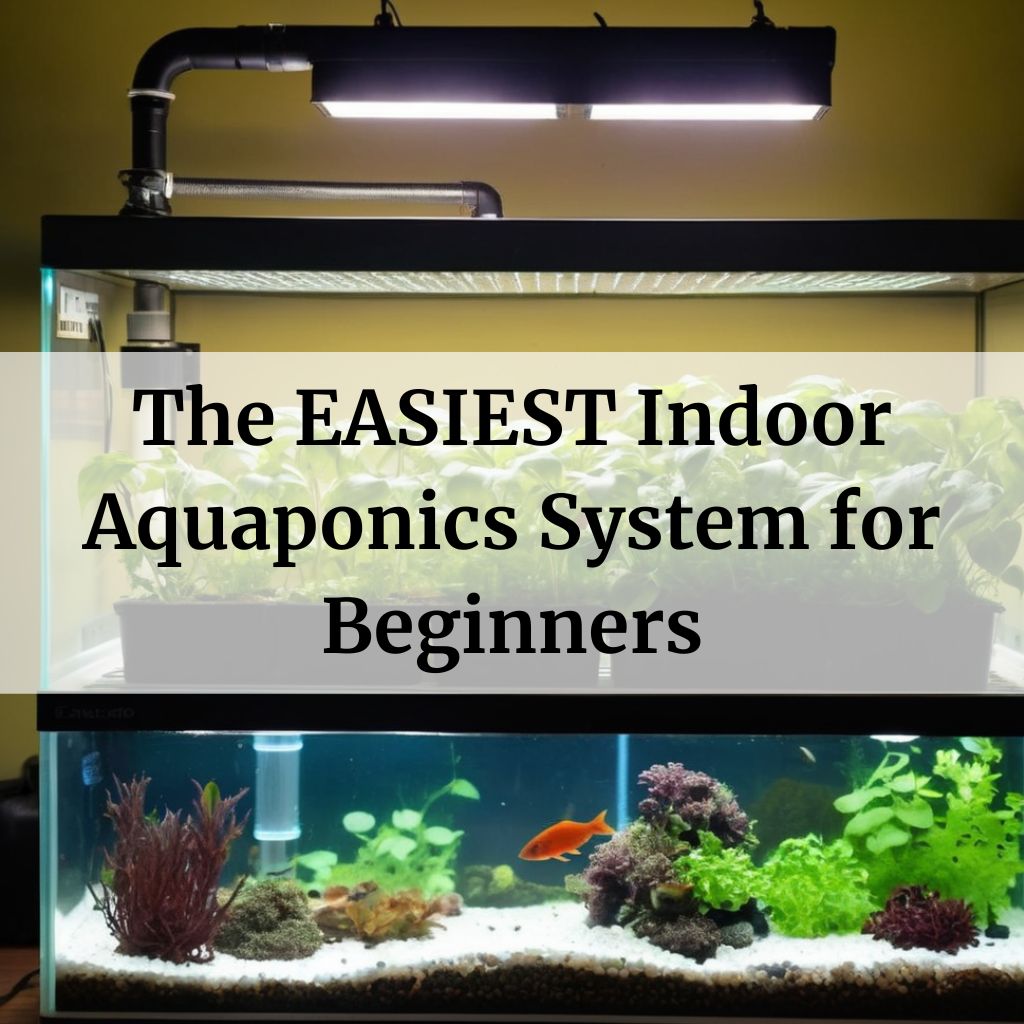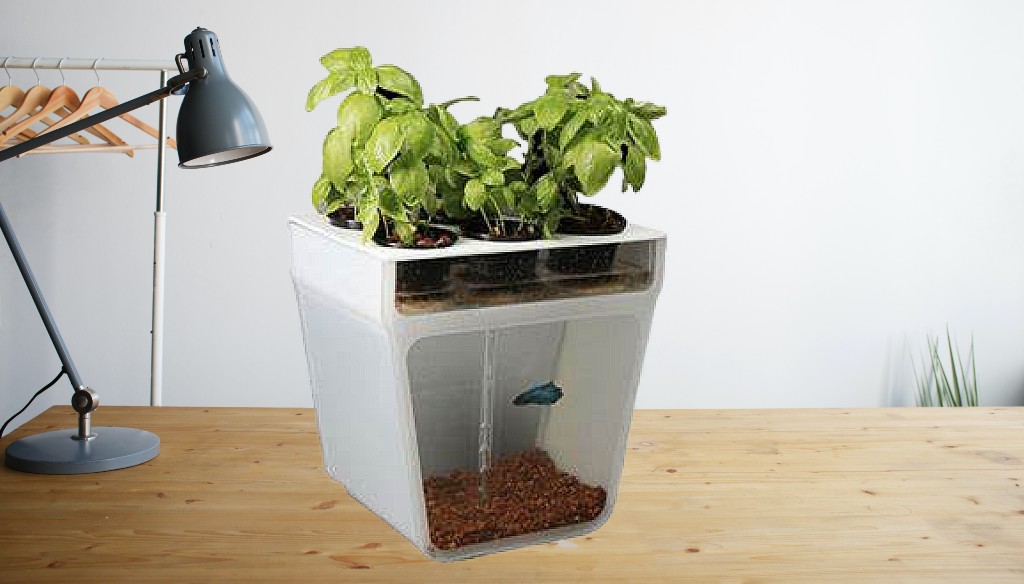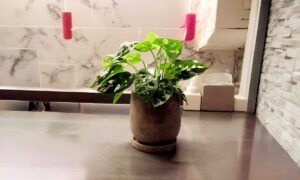
Aquaponics is a popular topic for beginners who want to grow plants and aquatic animals in a sustainable and eco-friendly way. Unlike hydroponics, aquaponics uses aquatic animals to provide nutrients through natural fertilization instead of adding a nutrient solution to the water supply.
Aquaponics is an ideal choice for anyone who already enjoys raising fish, prawns, crayfish, or other aquatic animals, and it’s perfect for anyone who wants to incorporate their aquarium into their garden.
In this article we look at the easiest indoor aquaponics system for beginners, and how to set up your own thriving aquaponic garden.
In this article
What Supplies Do You Need?
When setting up an aquaponics system, there are several essential supplies you’ll need to ensure the success of your project. Regardless of the specific setup, these key items are crucial for beginners venturing into aquaponics:
Fish Tank & Fish

A fish tank suitable for aquatic life is essential. Additionally, you’ll need fish or other aquatic animals to populate the tank. The choice of aquatic animals can range from small goldfish to farmable fish like prawns, crayfish, mussels, koi, and trout.
Note that small tanks (and thereby the entire aquaponic systems) are prone to chemical instability, which may endanger both fish and plants.
Plants & Container
Select the type of plants you intend to grow within your aquaponics system. Depending on your setup, you may grow small, light plants such as lettuce or strawberries, or larger plants like tomatoes and melons. Ensure that your setup can support the structural needs of the plants and provide them with ample nutrients.
A windowsill container box that is the same length and width of your fish tank and can fit on top of your fishtank is ideal. Make sure your container can support the weight of the plants you intend to grow.
Water Pump & Filter
A water pump is necessary to circulate water from the fish tank into the hydroponic system. Here are some water pumps recommended for use in aquaponics systems:
- Newpol 660GPH Submersible Pump: This ultra-quiet water pump is suitable for aquariums, water features, ponds, fountains, and hydroponic systems. It provides efficient water circulation and is ideal for smaller aquaponics systems.
- Pennington Aquagarden Universal Fountain Pump: This pump is suitable for garden fountains, water features, aquaponics, and hydroponics. It offers reliable performance and is designed for smaller to medium-sized aquaponics setups.
- Kulife Aquarium Air Pump: This air pump is suitable for fish tanks, pond aeration, and hydroponic systems. It provides efficient aeration and can be used in smaller aquaponics setups.
- FREESEA 330 GPH Submersible Water Pump: This submersible water pump is suitable for ponds, aquariums, hydroponics, fish tanks, and waterfalls. It offers reliable water circulation and is suitable for smaller aquaponics systems.
- Pondmaster Magnetic Drive Pump: This pump is known for its efficiency and is suitable for larger aquaponics systems. It provides reliable water circulation and is ideal for maintaining larger aquaponic setups.
When selecting a water pump for an aquaponics system, it’s important to consider factors such as flow rate, head height, and the size of the system. Submersible pumps are commonly used in household aquaponics systems, while inline pumps are preferred for larger commercial systems.
Additionally, filter materials play a crucial role in maintaining water quality and ensuring the overall health of aquatic animals and plants in aquaponics systems.
Here are some commonly used filter materials you could use:
- Matala Mesh Sheets: Matala mesh sheets are used in raft filters to manually clean solid waste when it accumulates. These sheets provide an effective means of removing solid waste from the water in aquaponics systems.
- Bird Netting: Bird netting is a popular method for solids filtration in large aquaponics systems. It is used in combination with a clarifier to eliminate solids from the water.
- Sponge: A sponge is a type of filter media used to catch solid waste and keep the water clean in aquaponics systems. It can effectively remove decaying organic matter and excess food from the tank.
- Filter floss: Aquarium filter floss is typically made of fine polyester fiber and is recommended for use in all aquarium filters. Aquarium filter floss is available in different forms, such as rolls or bags, and can be cut and shaped to fit specific filtration systems.
Grow Bed & Tubing
Plants require a grow bed to sit in, allowing their roots to access the water from the fish tank. A grow bed is a raised container or structure used for growing plants. It is typically designed to hold a growing medium, such as hydroton, and provide a suitable environment for plant roots to access the nutrient-rich water from the fish tank.
Tubes or piping will be required to provide a route for water from the fish tank to the grow bed and back again.
Grow Lights
If your aquaponics system is not exposed to direct sunlight, you may need to invest in grow lights to provide the necessary energy for plant growth. For lights, I recommend using Full Spectrum Grow Lights:
- Mars Hydro TSW2000: This model is known for its affordability and is a perfect lighting solution for 4-8 plants. It provides a full spectrum of light and is suitable for home-use LED grow lights1.
- VIPARSPECTRA Reflector-Series 600W: This LED grow light is available in different wattages and offers a wide color spectrum. It comes with a 3-year warranty and a 30-day product return policy, making it a reliable choice for indoor aquaponics systems2.
- California Lightworks Solarstorm 440-watt LED with UVB: This high-end LED light from California Lightworks is recommended for its advanced features and full spectrum coverage, making it suitable for indoor plant growth2.
- Horticulture Lighting Group Scorpion Diablo: This fixture is ideal for hobbyists and commercial growers, offering high-quality yields and a 5-year warranty. It is designed to provide a full spectrum of light for optimal plant growth3.
- Kind LED Grow Lights: Kind LED specializes in designing and manufacturing high-quality LED grow lights that provide plants with the light spectrum they need for thriving growth. Their LED grow lights are widely considered to maximize yields and potency, making them suitable for indoor aquaponics systems5.
When selecting full spectrum LED grow lights for indoor aquaponics systems, it’s important to consider factors such as light intensity, spectrum coverage, energy efficiency, and the specific needs of the plants being grown.
pH Testing Kit and Water Heater
If your aquaponics system is not exposed to direct sunlight, you may need to invest in grow lights to provide the necessary energy for plant growth. A pH testing kit and a water heater may also be necessary, depending on the species of fish and plants you are raising and their sensitivity to temperature.
Barrel, Drill, and Jigsaw
If you prefer a do-it-yourself approach, you may need a barrel, drill, and jigsaw to construct a simple aquaponics system.
The Easiest DIY Indoor Aquaponic System
Not all aquaponic setups are made completely from scratch. Many people already have a fish tank, and are looking for a way to upgrade it to an aquaponic system.
The aquaculture component is an aquarium featuring four goldfish. The corner pump brings the water upward to the plant bed – a common window still elongated pot containing the hydroton medium.
The interesting twist is that the grow bed input pipe is completely snuggled into a standard aquarium filter floss, which acts as a filter (the author also states that there are wiggler worms living inside it, though they are not shown), plus ensures gentle flow of the grow bed.
The system is equipped with a timer that enables the water to flood the grow bed every 15 minutes. The water is drained back into the fish tank.
The system uses additional lightning for both tank and the plant bed, and an improvised aluminum foil light box for increased plant growth. Therefore, it is designed and ideal for places with low or no natural light, i.e. your garage.
Aquaponics Kits for Beginners

If you aren’t interested in building your own aquaponics system you can purchase kits that are pretty much all set up for you. For a super small system that can fit right on your kitchen counter, try the Back to the Roots Aquaponics Ecosystem.
The Ecolife Aquaponics Indoor Garden System is a little larger and it comes with an LED light to help your plants grow faster. You can also simply place your plants into a few Aquaponics Floating Pond Baskets and allow the nutrients within your fish pond do the rest of the work.
Setting Up an Outdoor Aquaponics System
If you have an existing outdoors herb garden you can setup own aquaponics system. In this video, Rob runs through how a Basic Aquaponics System works and then looks at several basic aquaponics systems to help you all out with a few design ideas.
Level Up Your Aquaponics Knowledge
- Educational Resources: Books, webinars, and online courses can provide in-depth guidance for beginners and experienced aquaponic gardeners. These resources can be a valuable source of knowledge for tackling challenges.
- Local Experts: Connecting with local gardening clubs, aquaponics enthusiasts, or agriculture extension offices can provide hands-on knowledge and valuable assistance for newcomers.
Frequently asked questions
What is hydroton?
Hydroton, also known as lightweight expanded clay aggregate (LECA), is a type of growing medium commonly used in hydroponics and aquaponics systems. It is made by heating clay to over 2,000 degrees Fahrenheit, which causes it to expand like popcorn, resulting in a lightweight, porous material with a high surface area.
Hydroton is popular for its ability to retain moisture while also providing excellent aeration to plant roots. It is pH-neutral and does not compact over time, allowing for healthy root growth and efficient nutrient uptake by the plants.
Hydroton is often used in aquaponics grow beds to support the growth of various plants, providing a stable and supportive medium for the roots while facilitating the circulation of water and nutrients within the system.
What is aquarium filter floss?
Aquarium filter floss is a dense mechanical filter media designed to remove fine and coarse particulate matter from aquarium systems. It is commonly used in various filtration systems in both freshwater and marine aquariums.
The filter floss helps prevent obstructions in the biological media, reducing the risk of fish stress and disease, while also contributing to maintaining crystal clear aquarium water.
It is typically made of fine polyester fiber and is recommended for use in all aquarium filters. Aquarium filter floss is available in different forms, such as rolls or bags, and can be cut and shaped to fit specific filtration systems.
By understanding your specific requirements and selecting a system that aligns with your goals and resources, beginners can avoid costly mistakes and embark on a rewarding journey into the world of aquaponics, enjoying year-round gardening and a continuous supply of fresh produce regardless of external climate or season.
Happy gardening!







